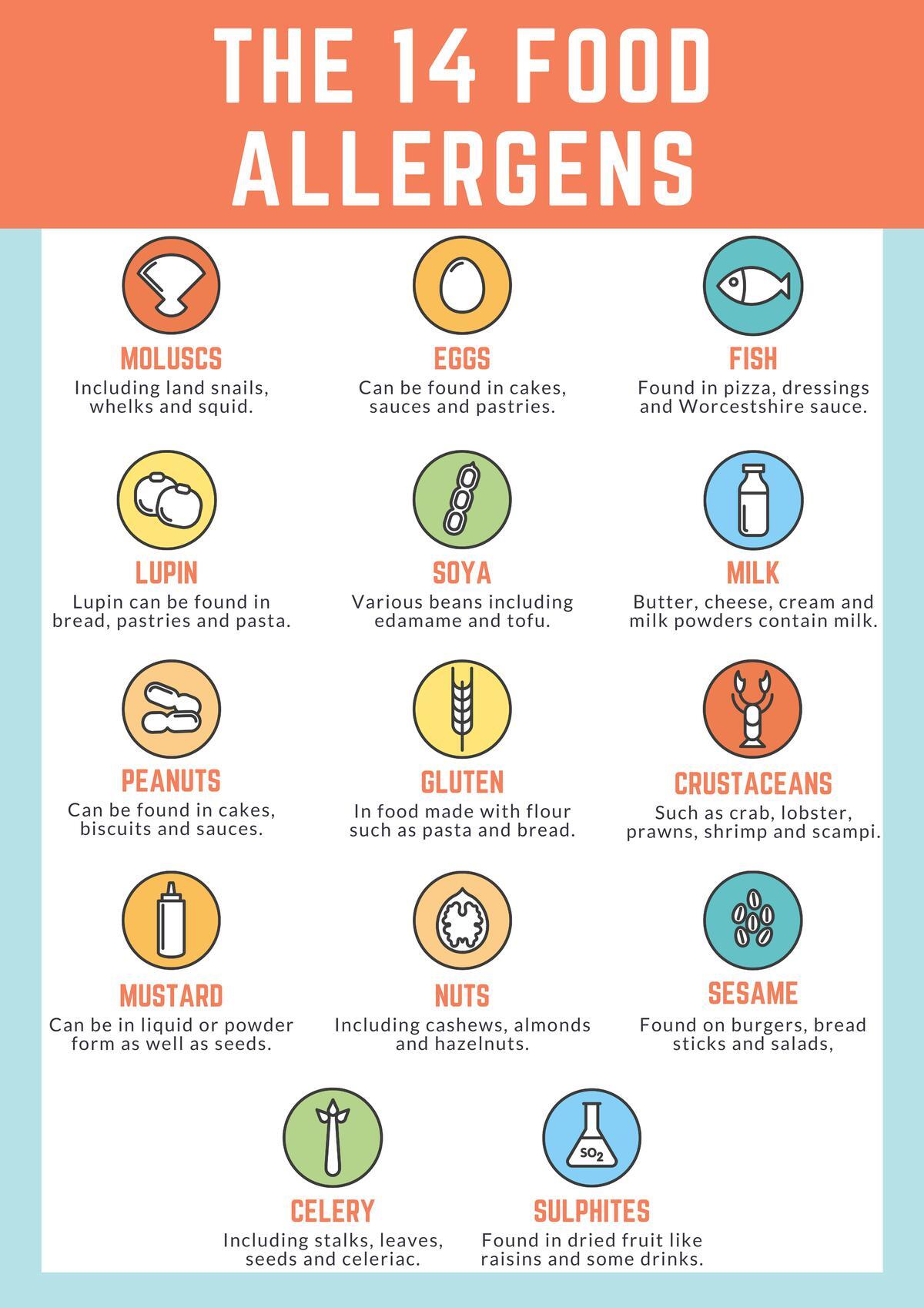In this article
Food businesses in the UK have been required since December 2014 to be aware of 14 prescribed allergens in their food. These are 14 different allergens that need to be pointed out to all customers so that someone with an allergy can make an informed choice of what they can eat.
The 14 food allergens are:
Celery
This includes celery stalks, leaves, spice and celery salt. It is often found in salads, some meat products, soups and stock cubes. People with a celery allergy also need to avoid celeriac, as they are varieties of the same species. This particular allergy is more of a problem in other European countries such as Switzerland, France and Germany, and not common in the UK, but because this list of allergens has been compiled as an EU wide initiative, it has been included.
Gluten
Gluten is the name of a family of proteins found in wheat, barley, rye and oats. It is often found in foods containing flour and therefore bread, baked goods, cereals and pasta. It can also be found in barley-based products such as beer, malt, malt vinegar and food colouring.
Crustaceans
These include crabs, lobsters, prawns, crabs and scampi. They are invertebrates and have segmented bodies and jointed legs. They are often found in shrimp paste used for curries. Around 60% of people with a shellfish allergy experience their first symptoms as adults. This allergy can be suffered even without eating. The proteins in shellfish can be transmitted through the air when fish is cooked. As this allergy can be severe in many, it is especially important for sufferers to be careful. Having an allergy to molluscs increases the risk.

Eggs
These are often found in cakes, some meat products, mayonnaise, mousses, pasta, quiche and food brushed with egg. Egg allergy is one of the most common foods to trigger allergic symptoms in babies and young children, however most children outgrow the allergy. Egg allergy can occasionally develop later in life. Reactions to egg are usually triggered by the protein part of the egg, mainly the white or albumen. Having another type of allergy increases the risk. Eggs do not have to be eaten to cause a reaction, and coming into contact with eggshells or raw egg may trigger a reaction in sensitive individuals.
Fish
Often found in fish sauces, pizzas, relishes, salad dressings and stock cubes. Fish and shellfish allergies are one of the most common allergies in adults, and can develop at any point in life with no previous symptoms experienced when eating fish. Because of the multiple uses and widespread use of fish in cooking, it is especially important for individuals with a fish allergy to know exactly what is in their food. Although treated as separate allergies, a fish, crustacean or mollusc allergy increases the risk of having another of these three.
Lupin
This includes lupin seeds and flour and can be found in some types of bread, pastries and pasta. Sometimes called lupine, it is a legume belonging to the same family as peanuts. It is frequently consumed in the Mediterranean, especially in the form of lupin flour. Lupin beans are eaten whole after boiling and drying as a snack in many countries.
Milk
This is found in butter, cheese, cream, milk powders, yoghurt and foods glazed with milk. Cow’s milk allergy affects around 3-6% of infants and young children and causes many health problems. It frequently takes many months to be diagnosed. The enzyme lactose is the cause of the allergic reaction. Many children outgrow a milk allergy and this allergy is uncommon in adults.

Molluscs
These include mussels, land snails, squid and whelks. They are often found in oyster sauce or as an ingredient in fish stews. Molluscs are soft bodied invertebrates, with some having a shell. Those that have a shell which opens and closes are called bivalve molluscs such as oysters and clams. As with fish and crustaceans, an allergy to one will increase the risk of being allergic to one or both of the others.
Mustard
This includes mustard powder, liquid mustard and mustard seeds. It is often found in breads, curries, marinades, meat products, salad dressing, sauces and soups. Because it is often hidden as an ingredient it is important to note it may not be obvious by sight, smell or taste. Mustard seeds are produced by the mustard plant, a member of the Brassica family. The seeds vary in colour and are frequently ground down to use in cooking. Mustard allergy is more common in countries where it forms a larger part of the cuisine such as in France. Mustard allergy can occur when there is a reaction between a food and a pollen allergen. Mugwort-mustard allergy syndrome occurs when a person becomes sensitised to a weed called mugwort. It affects those with hay fever and who react to foods eaten from the wider mustard family.
Did you know – According to AllergyUK 20% of the population in the UK is affected by one or more allergic disorder.
Nuts
These include almonds, hazelnuts, walnuts, cashews, pecan nuts, Brazil nuts, pistachio nuts, macadamia or Queensland nuts. They can be found in breads, biscuits, crackers, desserts, ice cream, marzipan, nut oils and sauces. Ground, crushed or flaked almonds are often used in Asian cooking. It is most common to develop a tree nut allergy before the age of 5, but also possible for adults and older children to develop a nut allergy, even when nuts have been previously eaten with no reaction. Those with a peanut allergy have a 30-40% likelihood of developing a tree nut allergy as they have similar proteins. People with a nut allergy are more at risk of being allergic to sesame seeds due to similarity in proteins.

Peanuts
These can be found in biscuits, cakes, curries, desserts and sauces. They are also in groundnut oil and peanut flour. Peanut allergy affects around 2% of children in the UK, and has risen in past decades. Peanuts are a legume and different from tree nuts, but they have proteins that are similar. An allergy to peanuts does increase the likelihood of developing an allergy to nuts, sesame seeds and lupin. Signs and symptoms of a peanut allergy can occur within minutes of contact, but can take an hour to be apparent. Because of the often severe reaction to a peanut allergy, it is vital to check ingredient lists, especially from foods produced outside the EU where they are not required to highlight the presence of peanuts.
Sesame seeds
These can be found in bread, bread sticks, as a garnish, in hummus, sesame oil and tahini (sesame paste). Sesame allergy is becoming increasingly common and is now in the top 10 of UK allergens, due to increased consumption. In countries such as Israel, where it has been a widespread food for decades, sesame allergy is quite common. Sesame is known as Benne, Gingelly, Till or Teel, Simsim or Anjonjoli on foreign products. Many people with a mild allergy to sesame are able to eat buns coated with sesame seeds because the protein causing the allergy is only released when the seed is squashed or broken.
Sulphur dioxide
Sulphites are preservatives, used in dried fruit, meat products and vegetables as well as in wine and beer. Sulphur dioxide allergy is rare however sulphites can cause allergy-like symptoms in people with underlying conditions such as asthma. Sulphite sensitivity is thought to affect less than 2% of the general population, but more likely between 5% & 13% for asthmatics.
Soya
This can be found in bean curd, edamame seeds, miso paste, soya protein, soya flour, tofu and a very wide range of processed foods. It is often used in some desserts, ice cream, meat products, sauces and in vegetarian products. The soya bean is a legume, but reaction to other legumes does not necessarily produce allergies. Soya is widely used in food manufacture and is difficult to avoid with as much as 60% of manufactured foods containing soya. Avoidance of all foods containing soya is very difficult, however as with other allergens, the avoidance necessary depends on the severity of the allergy. In the UK the Food Standards Agency advises that refined soya oil (the main ingredient of vegetable oil) should be safe for most people because the proteins that cause the allergy are removed during the refining process. As with other foods, products sold outside the EU do not have to comply with EU allergen labelling legislation.







